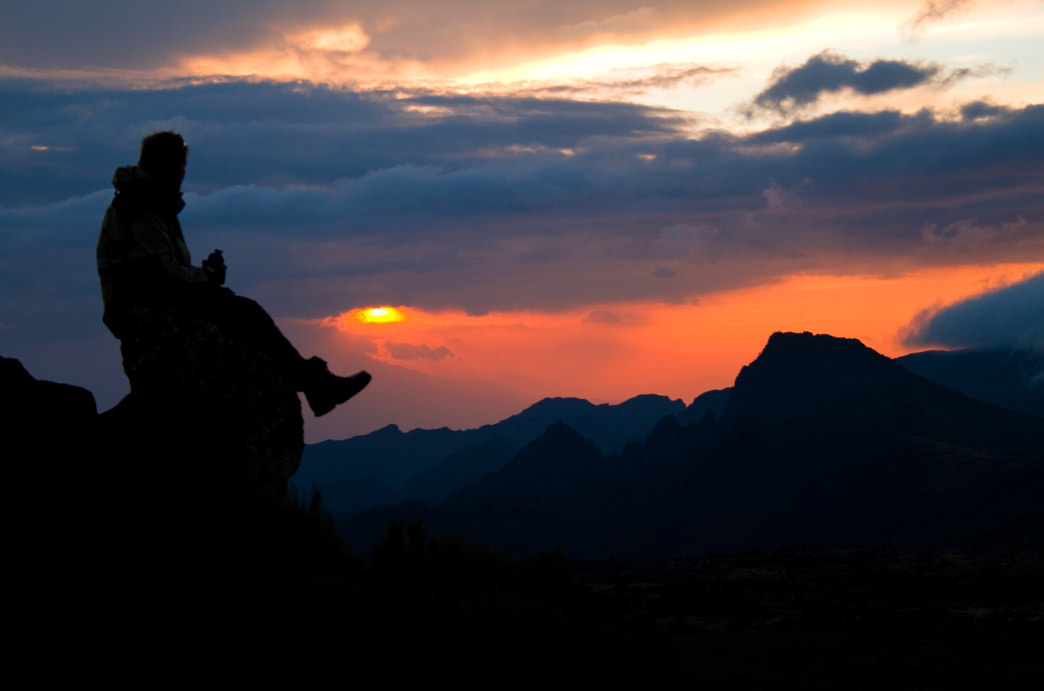The planet is crisscrossed with epic trails, from the Alps to the Andes. There are snowy summit trips for fleet-footed peak-baggers, long and leisurely rambles for wildlife lovers, and everything in between. While the options are almost infinite, here are a few epic hikes to add to that ever-expanding life list.
1. Kilimanjaro, Tanzania
One of the planet’s Seven Summits, 19,341-foot Kilimanjaro is the highest freestanding mountain on Earth—and Africa’s loftiest peak. Despite the distinction, the glaciated summit is accessible courtesy of a number of a non-technical routes, leading climbers through five distinctly different climate zones. On the path to Uhuru Peak, trekkers traverse a lowland rainforest inhabited by colobus and blue monkeys, ascend the scrubby montane moorland of the Shira Plateau, cross hulking glaciers, and catch glimpses of the megafauna-loaded grasslands of Kenya’s Amboseli National Park. At basecamp, vividly colored tents dot an unearthly moonscape, and climbers rest in the shadow of toothy 16,893-foot Mawenzi.
2. Table Mountain, South Africa
While the flat-topped mesa soaring above Cape Town is accessible by cable-car, the climb to the apex of 3,569-foot Table Mountain is one of the planet’s most spectacular treks—and a must-do for a visit to this dynamic city. Routes to the top of the 500 million-year-old massif treat ascending climbers to panoramic vistas of the pointed peaks of the Twelve Apostles, the azure water of Camps Bay, knobby Lion’s Head, and Cape Town’s bustling City Bowl. There are plenty of half-day routes to the mesa’s highest point, Maclear’s Beacon, including the three-hour slog through Skeleton Gorge, allowing hikers to encounter Cape dwarf chameleons, stealthy caracals, and vibrantly colored sunbirds. The climb can also be done as a multi-day trip along the Cape of Good Hope Trail or the Hoerikwaggo Trail, beginning at Cape Point.
3. Te Araroa Trail, New Zealand
Meaning "the long pathway," in Maori, New Zealand’s 1,864-mile Te Araroa Trail is the Kiwi version of America’s Appalachian Trail. Bookended by the Pacific Ocean, between Cape Regina and Bluff, the route runs through the heart of New Zealand, traversing both North and South islands and leading backpackers through a staggering diversity of landscapes: sun-drenched coastlines, subtropical rainforests, snow-dusted alpine passes, and river-braided glacial valleys. The epic trek also showcases many of New Zealand’s geological gems, including the Southern Alps, famed backdrop for the Lord of the Rings trilogy, and the still-active Tongariro volcano.
4. Annapurna Circuit, Nepal
Besides Everest, the most idolized Himalayan foray is Nepal’s Annapurna Circuit. The nearly 130-mile route horseshoes the Annapurna range’s sea of glaciated summits, capped by 26,545-foot Annapurna I. The high-altitude tour takes hardy trekkers through highlands terraced with rice paddies, across surging whitewater rivers, through shadowy rhododendron forests, over otherworldly mountain passes, and past Buddhist gompas and Hindu shrines. While backpackers on the circuit must tackle challenges like 17,768-foot Thorung La, the route is dotted with cozy tea houses affording creature comforts like brief but heavenly hot showers and steaming plates of dal bhat, a traditional meal of steamed rice and cooked lentil soup.
5. John Muir Trail, California
Named for legendary naturalist and founder of the Sierra Club, the John Muir Trail strings together two of California’s most spectacular natural wonders: the Yosemite Valley and 14,496-foot Mount Whitney, the highest point in the continental United States. Tracing the spine of the High Sierra, the 211-mile route moseys through three national parks and two federally designated wildernesses, leading hikers through a landscape of high peaks and passes, glassy alpine lakes, and sun-drenched mountain meadows. The trail skirts Half Dome in Yosemite National Park, and showcases natural wonders like the Devil’s Postpile National Monument and Evolution Basin in Kings Canyon National Park. Plus, hikers have ample opportunity to encounter black bears, mule deer, and curious marmots along the route.
6. Four Pass Loop, Colorado
The most photographed spot in Colorado, the snow-stripped twin peaks of the Maroon Bells are best celebrated on the epic Four Pass Loop through the Maroon Bells/Snowmass Wilderness. The aptly amed 26-mile circuit begins at turquoise-toned Maroon Lake, just west of Aspen, and takes backpackers over four alpine passes each higher than 12,000 feet, across airy meadows dusted with wildflowers, through spruce forests and copses of white-barked aspen, and past backcountry waterfalls and peak-framed lakes. Besides the Maroon Bells, the Elk Mountains sampler also provides trekkers the chance to gape at a handful of celestial fourteeners, including Pyramid Peak and Snowmass Mountain.
7. Beara Way, Ireland
Ringing Ireland’s wind-pummeled Beara Peninsula, a 48-mile sliver of land bisected by the Caha and Slieve Miskish mountains, the Beara Way provides a quintessential taste of the Emerald Isle and forms part of Ireland’s longest hiking trail, the Beara-Breifne Way. The 122-mile trek cobbles together bucolic country lanes, highland tracks, and ancient roads, offering a glimpse of the peninsula’s colorful past. Following the path taken by Beara’s last chieftain, Donal Cam O’Sullivan Beare, as he fled hotly pursuing Elizabethan troops in 1603, the Beara Way takes trekkers past Neolithic and Bronze Age sites, through charming towns, and over craggy highlands. Fortunately, the lung-taxing climbs and knee-grating descents are greeted with panoramic vistas of the rugged coastline, including the shimmering waters of Bantry Bay, staging point for Theobald Wolfe Tone’s infamous but ill-fated 1786 rebellion.
8. Cotopaxi, Ecuador
One of the peaks in Ecuador’s Avenue of Volcanoes, 19,347-foot Cotopaxi soars above the high Andean páramo of Cotopaxi National Park. Although the peak is the second highest in Ecuador—and one of the loftiest active volcanoes on the planet—Cotopaxi is scalable without prior mountaineering experience. Ropes, crampons, and ice axes are required to reach the snow-capped pinnacle, but with the help of local guides (and after a quick hands-on introduction to mountaineering), the crater-pocked peak is reachable for most reasonably fit trekkers. Along the way to the summit, hikers have the chance to spot wild horses, llamas, and spectacled bears (the ursine species credited with inspiring the fictional character Paddington).
9. Inca Trail, Peru
The most celebrated trek in South America, this Andean excursion takes hikers from the Sacred Valley to Machu Picchu, the stone-hewn urban center crafted by the Incas during the 15th century, a World Heritage site since 1983. Along the way to Machu Picchu, the 24-mile trek follows paths forged by the Incas more than 500 years ago, meandering through cloud forests studded with 300 types of orchids, over three cloud-shrouded mountain passes, and past pre-Columbian ruins. Stashed away at 7,972 feet, the Historic Sanctuary of Machu Picchu is also a biodiversity hotspot, serving as an ecological corridor linking the Andes, Sacred Valley, and Amazon, and affording trekkers the opportunity to spot 370 different types of bird, including mammoth Andean condors.
10. Mount Kinabalu, Malaysia
Soaring above other peaks in Malaysian Borneo’s Crocker Range, 13,435-foot Mount Kinabalu is the loftiest summit in Southeast Asia. Gunung Kinabalu, as the peak is known in Malay, is also the country’s first World Heritage site, a global hotspot for flora and fauna. The mountain’s ecosystems harbor more than 5,000 types of plants, over 300 species of birds, and 100 different mammals. Along the path to the granite-tipped summit, which typically takes two to three days round-trip, lush lowland rainforests give way to cloud-bathed montane and coniferous forests, providing the chance to spot orangutans, Bornean gibbons, and long-tailed Bornean Treepies. The mountain’s six different vegetation zones also support a thousand different orchids and five endemic species of carnivorous pitcher plants, including the largest on earth, Nepenthes rajah.
11. Tour du Mont Blanc, Western Europe
While scaling 15,781-foot Mont Blanc requires extensive mountaineering knowhow, more casual hikers can still get an eyeful of Western Europe’s loftiest summit from three different countries—France, Italy, and Switzerland—on the Tour du Mont Blanc. The 105-mile route rings the entire snow-frosted massif, traipsing over seven alpine passes, past storybook alpine hamlets, along colossal glaciers, and through wildflower-freckled meadows. Besides the spellbinding scenery, the Tour du Mont Blanc also provides a snapshot of regional culture, taking hikers through historic locales like medieval Courmayeur. Best of all, while physically taxing, the route is scattered with cozy alpine huts, affording plenty of opportunity to swap freeze-dried fare for fondue.
12. Torres del Paine Circuit, Patagonia, Chile
Towering above the guanaco-grazed steppes of Chilean Patagonia, the trio of granite pillars dubbed Torres del Paine comprise one of the most iconic massifs on earth. The blue-hued granite cathedral tops out at 10,656 feet and crowns Torres del Paine National Park, a former sheep estancia declared a World Heritage site in 1978. Backpackers can gape at the granite monoliths from every angle imaginable along on a circuit trek on the national park’s non-technical trails. The more heavily trafficked ‘W’ configuration can be done in less than four days, while the more extensive ‘O’ circuit, takes about a week. Despite the rugged landscape of glaciated granite peaks, raging rivers, and iceberg-strewn alpine lakes, the Torres del Paine circuit can be done without forgoing creature comforts by cobbling together a route linking the park’s cozy refugios.
13. Kalalau Trail, Hawaii
Showcasing Kauai’s rugged Nā Pali Coast, where fluted mountains meld into the glistening Pacific Ocean, the Kalalau Trail is among the most spectacular coastal treks on earth. But, the 11-mile trek is no walk on the beach. Between Ke’e Beach and Kalalau Beach, the trail winds through five different valleys, across more than a half-dozen streams, and along precipitous cliff sides, including a vertiginous stretch aptly dubbed Crawler’s Ledge, for the hikers duly daunted by the 500-foot drop. Grit and determination are mandatory, but trekkers are rewarded with jaw-dropping views of the Pacific and gems like the 300-foot Hanakapi’ai Waterfall. While the 22-mile out-and-back trip can be done in a day, the route is scattered with stunning camping spots, like the area near 1,400-foot Hanakoa Falls, about halfway through the trek.
14. Mount Fuji, Japan
Located southwest of Tokyo, the solitary summit of 12,388-foot Mount Fuji is one of the planet’s most recognizable peaks. Dormant for just over 300 years, the snow-dusted stratovolcano has served as an artistic muse for centuries, revered as one of Japan’s Three Holy Mountains. Religious pilgrims have been scaling the sacred mountain since ancient times, and the climb remains exceedingly popular. Climbing season for Mount Fuji only runs from the beginning of July to the end of August, but more than 300,000 trekkers make the approximately six-hour trip every year. While there are celestial views on the way to the summit, the trek has the distinction of being one of the few climbs on the planet that is more cultural experience than wilderness excursion. Each of the four routes to the top offers mountain huts peddling food and drinks, and there is even a post office at the summit where you can drop a postcard to a lucky recipient.
15. Sunshine Coast Trail, British Columbia
Rambling along the wild Sunshine Coast in southwest British Columbia, the Sunshine Coast Trail is a less-frequented alternative to the West Coast Trail. Built entirely by volunteers and maintained by the non-profit Powell River Parks and Wilderness Society, the 112-mile trail ambles from Desolation Sound to Saltery Bay, taking trekkers through old growth rainforests roamed by black bears, grey wolves, and cougars. Wildlife watchers also have the chance to spot the blubbery bodies of Stellar sea lions and harbor seals along coastal stretches of the trail, and the route’s highest point—4,821-foot Mount Troutbridge—is a hotspot for seafaring marbled murrelets. Best of all, the Sunshine Coast Trail is Canada’s only free hut-to-hut track, with no reservations or permits required.
Written by Malee Baker Oot for RootsRated.
Featured image provided by Stig Nygaard

 Join us on our walk through some of the greatest treks on Earth.
Join us on our walk through some of the greatest treks on Earth.